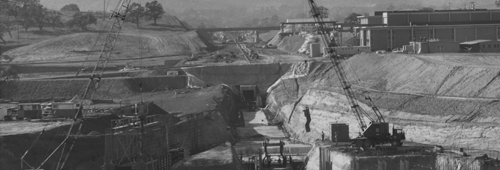SLAC History

In 1962, in the rolling hills west of Stanford University, construction began on the longest and straightest structure in the world. The linear particle accelerator – first dubbed Project M and affectionately known as "the Monster" to the scientists who conjured it – would accelerate electrons to nearly the speed of light for groundbreaking experiments in creating, identifying and studying subatomic particles.
Stanford University leased the land to the federal government for the new Stanford Linear Accelerator Center and provided the brainpower for the project, setting the stage for a productive and unique scientific partnership that continues today, made possible by the sustained support and oversight of the U.S. Department of Energy.
Soon after the new accelerator reached full operation, a research team including SLAC and Massachusetts Institute of Technology physicists used the electron beam to discover that protons in the atomic nucleus were composed of smaller entities called quarks. That research led to the 1990 Nobel Prize in Physics, shared by SLAC's Richard Taylor and Jerome I. Friedman and Henry Kendall of MIT.
A dozen years after SLAC’s founding, researchers again struck physics gold with discoveries that were made possible by the addition of the Stanford Positron Electron Asymmetric Ring (SPEAR). In what became known as the "November Revolution" in particle physics, experiments led by physicists Burton Richter at SLAC and Samuel Chao Chung Ting at Brookhaven National Laboratory announced their independent discoveries of the J/psi particle, which consists of a paired charm quark and anti-charm quark, in 1974. They received the Nobel Prize in Physics for this work in 1976.
And in 1975, SLAC physicist Martin Perl announced the discovery of the tau lepton, a heavy relative of the electron and the first of a new family of fundamental building blocks, for which he shared the Nobel Prize in Physics in 1995.
These discoveries and others that reshaped our understanding of matter were empowered by a series of colliders and detectors:
- The Positron-Electron Project (PEP), a collider ring with a diameter almost 10 times larger than SPEAR, ran from 1980-90.
- The Stanford Linear Collider, completed in 1987, allowed scientists to focus electron and positron beams from the original linear accelerator into micron-sized spots for collisions. The SLC hosted a decade of seminal experiments.
- PEP was followed by the PEP-II project, which included a set of two storage rings and operated from 1998-2008.
New research areas and projects at SLAC have often evolved as the offspring of the original linear accelerator and storage rings.
The Stanford Synchrotron Radiation Project, which opened to visiting researchers in 1974, used electromagnetic radiation generated by particles circling in SPEAR to explore samples at a molecular scale. Its modernized descendant, the Stanford Synchrotron Radiation Lightsource, now supports 30 experimental stations and about 2,000 visiting researchers a year. SPEAR, now known as SPEAR3 following a series of upgrades, became dedicated to SSRL operations 20 years ago and celebrates its 40th anniversary this year.
Roger D. Kornberg, professor of structural biology at Stanford, received the Nobel Prize in Chemistry in 2006 for work detailing how the genetic code in DNA is read and converted into a message that directs protein synthesis. Key aspects of that research were carried out at SSRL.
Meanwhile, sections of the linear accelerator that defined the lab and its mission in its formative years are still driving electron beams today as the high-energy backbone of two cutting-edge facilities: the world's first hard X-ray free-electron laser, the Linac Coherent Light Source (LCLS), which began operating in 2009, and FACET, a test bed for next-generation accelerator technologies.
An expansion of LCLS, dubbed LCLS-II, is slated to begin construction next year. It will draw electrons from the middle section of the original linear accelerator and use them to generate X-rays for probing matter with high resolution at the atomic scale.
SLAC's scientific mission has diversified from an original focus on particle physics and accelerator science into cosmology, materials and environmental sciences, biology, chemistry and alternative energy research.
Scientists still come by the thousands to use lab facilities for an even broader spectrum of experiments, from archaeology to drug development, industrial applications and even the analysis of dinosaur fossils and art objects. Much of this diversity in world-class experiments is based on continuing modernizations at SSRL and the unique capabilities of LCLS.
The lab's longstanding collaboration with CERN in Geneva, Switzerland provided an important spark in the formative years of the World Wide Web and led to SLAC's launch of the first Web server in the United States. SLAC is also playing an important role in the ATLAS experiment at CERN's Large Hadron Collider, an international endeavor to explore the tiniest components of matter, where the elusive Higgs particle seems to have been discovered recently.
Expertise in particle detectors has even elevated SLAC research into outer space. SLAC managed the development of the gamma ray-detecting Large Area Telescope, the main instrument aboard the Fermi Gamma-ray Space Telescope that launched into orbit in 2008 and continues to make numerous discoveries.
The lab has also earned a role in building the world's largest digital camera for an Earth-based observatory, the Large Synoptic Survey Telescope, scheduled to begin construction in 2014 for eventual operation on a Chilean mountaintop.
In 2012, the lab celebrated its 50th anniversary with a two-day series of events for employees, science luminaries and government and university leaders. It was more than a tribute to the momentous discoveries and Nobel Prizes made possible by the minds and machines at SLAC. It was also a look ahead at the lab's continuing evolution and growth into new frontiers of scientific research that will keep it at the forefront of discovery for decades to come.


